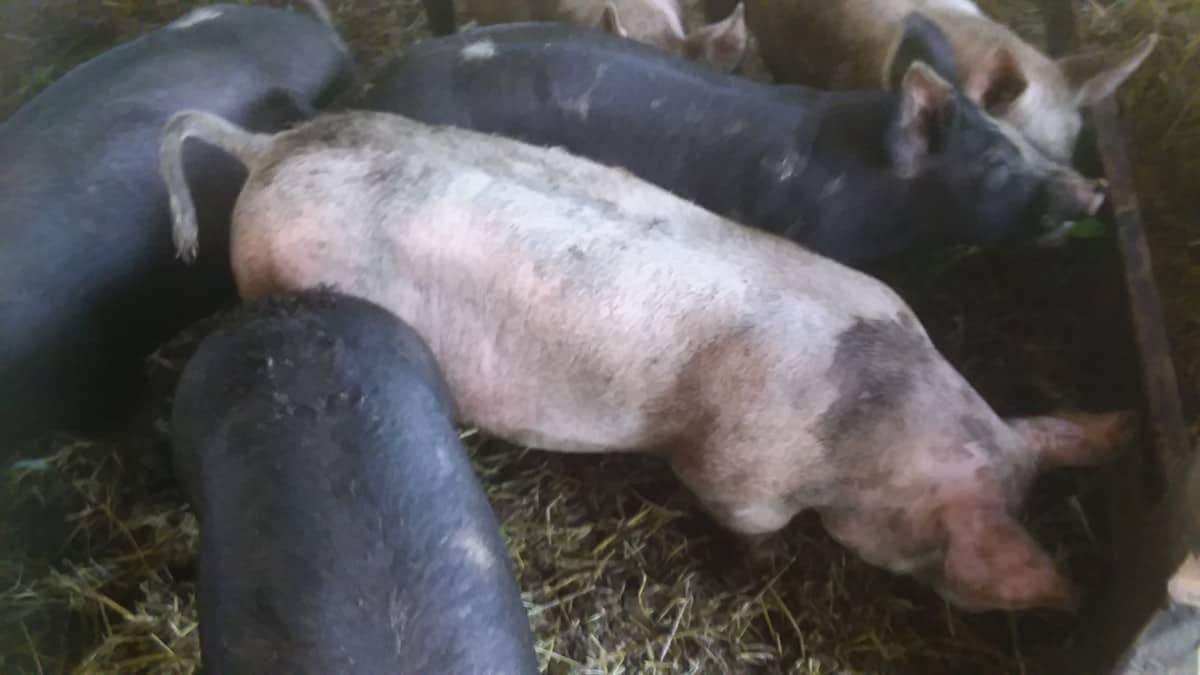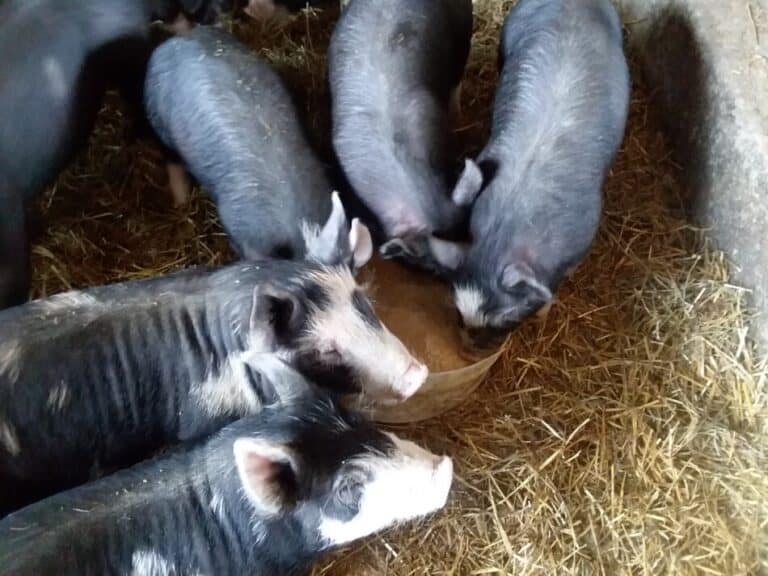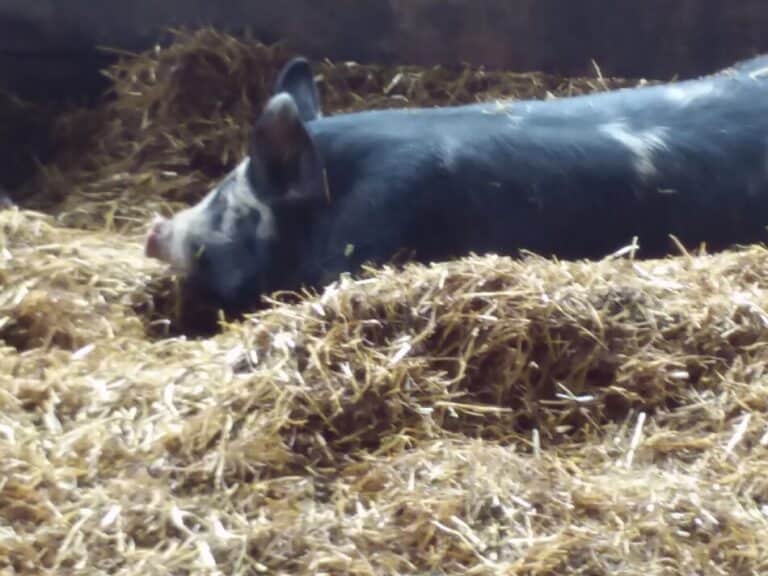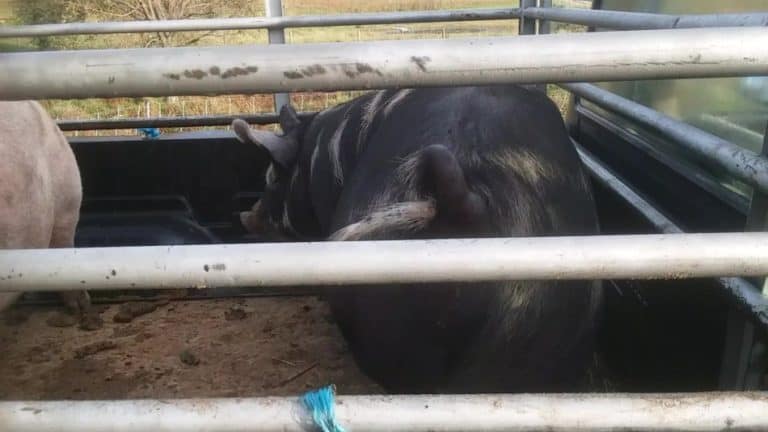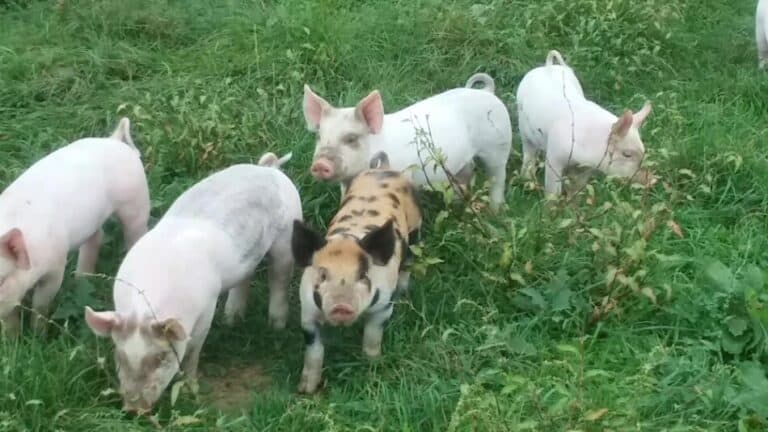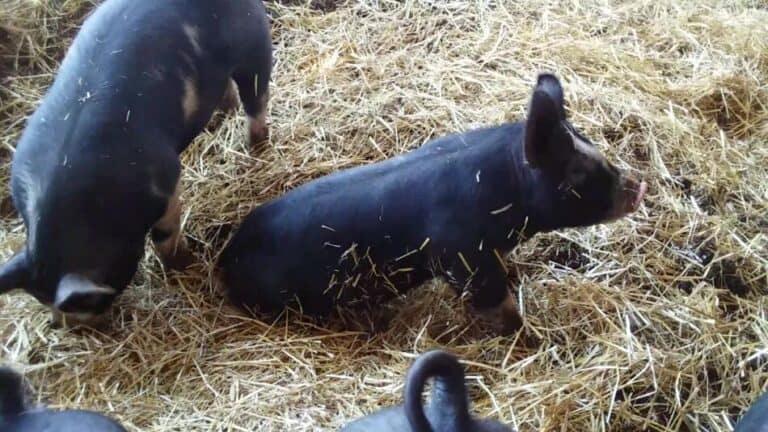Pigs: What Are Your Feed Options?
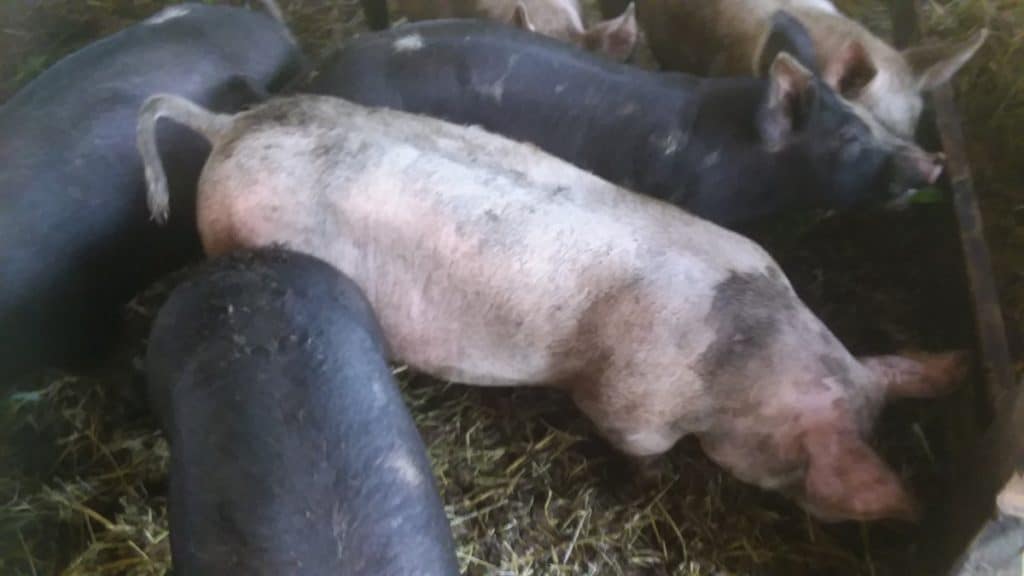
What to feed your pigs? I’m sure you’ve run across many opinions, varying widely, of course!
Just because the pig will eat it doesn’t mean it should eat it. So, what are your choices for your pig’s food?
While pigs are biologically designed to eat a variety of foods, they grow best when the majority of their food is specifically formulated ground feed.
Pigs are a great choice for raising your own food! They are pretty hardy, generally easy to find, especially if you want feeder pigs.
Natural Feeds For Pigs goes over what I consider to be your best pig feed option.
Feeder pigs get to butchering weight fast when you consider how much meat you are raising.
If you purchased a few 60 pound feeder pigs they will be ready to butcher, or sell in three months!
That means they will each put on about 200 pounds of weight in the next 90 days or so.
But…this will only work if they have the calories to make that growth happen!
How much will your feeder pigs cost to raise? Read my article Cost To Raise A Feeder Pig
The new cool thing is raising pigs without grain.
I love the idea-but we still feed grain. Why? Money. For us grain just makes the most sense.
No matter what you feed your pigs, you still need to provide the calories the pig needs for it’s daily growth.
The reason most people raise pigs on grain is because grain is the most economical way to raise the pig to butchering weight.
Pig food needs to provide plentiful calories
Grain (feed) is not mandatory but ample calories are. A body requires fuel to grow and faster growth requires more fuel.
The beauty of an omnivore is that it can eat and thrive on a huge variety of feeds.
Your pigs will love to eat all kinds of things, but the question is how well will they grow on that feed?
Can you find the food source you want to use for your pigs
The main consideration with any feed source is can you get it/buy it? And will it do the job for your pigs?
First off, your feed needs to be affordable and obtainable.
If you can’t pay for it or get a hold of it when you need it then it won’t work.
Your pigs are counting on you for their food everyday, not just when you find a deal.
The second part here is that the feed source has to do the job for your pigs. Just like you can not live on lettuce alone, neither can your pigs.
If you want to avoid grain for your pigs, that is completely doable.
Be aware that without grain it will take your pigs much longer than normal to get to a butchering weight.
Pig Feeding Guide from Osbourne Livestock Equipment has a list of common foods that pigs can eat and ones that are best avoided.
Special pig feeds (organic, non GMO) are available
I have not made any distinction between the sources of grain, meaning organic, non GMO, conventional and so on.
If organic, for example, is important to you, then find a source of organic pig feed.
Either way the calories will be about the same regardless of the way the grain was raised, so choose what suits you best.

Pig diet changes pork flavor
Feed: no grain, all forages and plants like pumpkins
Pros: tons of flavor in the meat
Cons: more land needed, takes longer to finish out, sourcing alternative feeds will be needed as long as you have the pigs
The best information I have found on finishing out pigs without grain, meaning they eat forages and vegetables like turnips and pumpkins, is from Sugar Mountain Farm.
This is a farrow (birth) to finish hog farm that is completely on pasture.
They also recently finished an on farm processing plant so they can cut up and sell their own pigs retail.
Sugar Mountain does not feed any grain, because where they live (Vermont) grain is expensive to buy and have trucked to the farm.
Of course, they do supplement the pigs diets with other higher calorie plants like sunflowers and their pastures are a mix of forages, not just grass.
Remember: Pigs are omnivores, like us, so they need more calories than just grass can provide.
Pastured pigs have free choice grain
Feed: ground feed as the animal wants it and pasture
Pros: pigs have a great time outside, no manure to haul out
Cons: pigs root, can run around excessively (needing more feed to make weight gains) and feeders need to be covered (rain), no loading facility
This is my preferred method of raising pigs, I love to see them out rooting around.
However, pigs on pasture will rough up the area they have access to. It is natural and normal, they are pigs, after all.
If put on pasture, your pigs will eat all manner of plants and animals (by that I mean bugs) that they can get a hold of.
Your pigs will still need feed and water, even with all they can eat pasture.
When we had pigs on pasture they were eating regular ground hog feed and being kept in with a single strand of electric wire.
We had Tamworths at the time.
The were very friendly pigs, even the adults, but they did run around the pasture a lot, leading us to think that a less active pig might do better.
The Tamworths seemed to be just running off their feed calories vs. gaining well.
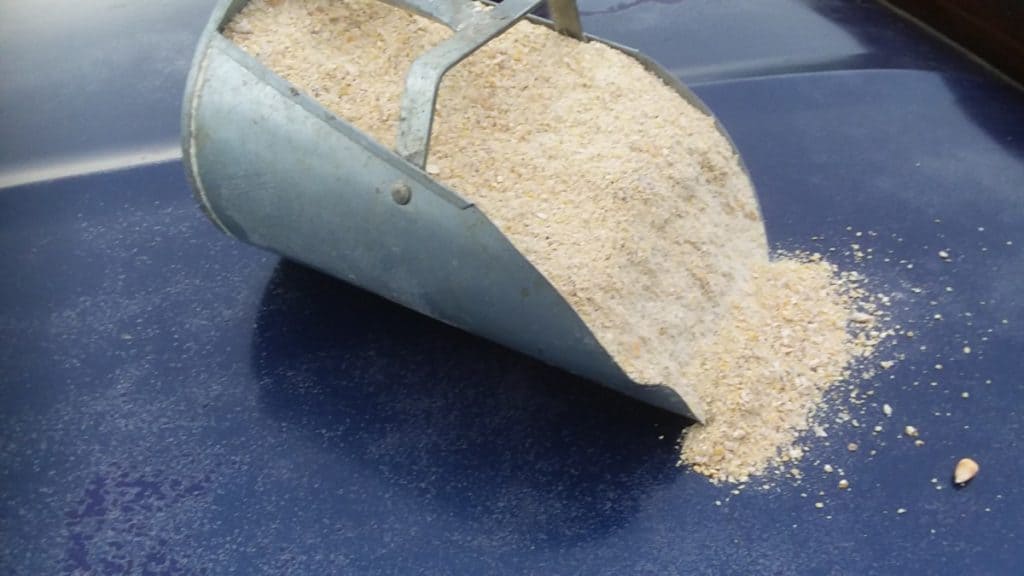
Pastured pigs also require feeders and waterers that can be put out in the field with the pigs.
Generally this just means that the pigs shouldn’t be able to get to the water line, otherwise they will “play” with it and break it.
The second thing is that the feeder needs to have a secure lid.
This is mostly to keep out the rain, but will also keep out birds or other non pig feed eaters.
Don’t worry, there will be plenty off spills for birds or any other opportunist who can wander in, since pigs are enthusiastic (read messy) eaters.
To me, since I’m paying for the feed, my pigs should get first crack at eating it!
If you have birds, like chickens, that are loose, they’ll soon figure out to head on over to the pig pasture for snacks.
One last consideration, if your pasture does not have shade then you need to figure out how to get your pigs a cool place to hang out when they need it.
It does not have to be fancy, but some sort of shade does has to be available to them to keep them happy and comfortable.
Pigs can be pen raised on grain only
Feed: ground feed as much as they want, any other edibles must be taken to the pigs
Pros: pigs always have shelter, easy to check on and fill feeder and waterer and no rooting up of the pasture
Cons: no access to other edibles and manure to haul out
Now that my pigs are old enough to get into trouble running around the barnyard I had to pen them up.
They were going into another building and messing with electrical cords! I loved having them zoom around but that had to stop.
I could give them a run in the adjacent pasture and I probably will, once they are done working.
Working? Doing what? Actually they are saving me a lot of pitchfork work, that’s what. I have them in the pen the March lambs were born in.
The pen is built up quite high with bedding that will be hard to get out of there, even with a loader.
The hay makes a hay and manure pack that is like a thick carpet, so it just slides out of the loader.
Some people have a pincher attachment that grabs the bedding, but we just have a pitchfork!
Let you pigs root around inside a building
Anyway, the pigs will root around the bedded pack looking for snacks and turn the tightly packed hay/straw/sheep poop mix into compost.
Seriously, when they are done working the bedding, you can grab a handful of it and it feels like very fine mulch, like for flower beds, and smells like soil.
I love their work and they love doing it.
The only down side to keeping working on the bedded pack is they need to be kept in the pen, so no outside time until they are finished.

In the pen they eat a ground feed that we make ourselves from our own corn.
It contains purchased soybean meal and a mineral supplement that get mixed in with the ground corn, then put into their bulk feeder.
Need more details? Check out my article How Fast Do Pigs Grow for more specifics.
The feed mix has a different protein percentage depending upon the age/weight of the pigs.
As the grow they need less protein in each pound of feed. We use the directions on the tag.
There is a bit of math involved since the tag lists the feed mix per ton and we do per 500 pounds (a 1/4 ton), but overall it’s pretty easy.
Our group of pigs are currently weighing around 140 pounds each so they get a 13.95 % protein ration.
When they were piglets it was 21%, as smaller feeders it was 16%, then once they are over 180 pounds each they will get 12.80% protein.
Water-the most important part of your pig’s ration
We also have a big water barrel (55 gallon) with a push button water cup at the bottom, so water is free choice and always available.
Water is often overlooked in relationship to feed consumption and therefore growth.
Limiting water will limit growth of your animals. They need ample water to process their food, just like you do.
Plenty of water is especially important when you are feeding dry feed vs forage which would have some moisture.
I also give my pigs a wallow of sorts.
Really, it’s just a spot with extra water poured on it for the days when it is really smoking hot around here. They need to be able to cool off.
It does make that end of the pen a mess, but the pen is plenty big and after they cool off they can go eat more!
All pigs like snacks to eat
Now, just because you are pen feeding doesn’t mean your porkers want only feed!
Give them kitchen scraps or weeds from the garden along with any damaged or overripe fruits and vegetables from your garden.
Pigs also like hay to snack on and whatever they don’t eat they will lay on so nothing is wasted.
If you have other animals that aren’t eating all of their hay, give the left over pieces to your pigs when you put in fresh hay.
Forest raised pork is traditionally no grain
Feed: pigs eat whatever they find in the area, mostly acorns
Pros: unique taste, commands extremely high prices
Cons: area specific, takes a long time to maturity
This is the traditional Iberian pork, no grain free to wander and living on whatever they can find, most of which is acorns.
That’s what gives the pork it’s famous flavor, and famous price!
If you have the set up for this, go for it! This sounds amazing, and imagine the unbelievable flavor!
Be sure to get your pigs from a farm that raises them in a similar fashion as you plan to raise yours.
The pigs will learn a tremendous amount from foraging around with their mom, you need them to know this.
Plus that farm will have genetics adapted to this type of a system.
Sadly, we do not have the land suited for this type of pig raising so I have never even made an attempt with this method.
If you feel this is the way for you, know that since your pigs have to work harder to find their food, it will take them longer to grow.
That is the trade off for amazing flavor.
Forest raised pigs with free choice grain
Feed: ground feed as much as wanted, whatever they find in the wooded area of their pen
Pros: great flavor to meat, pigs have room to play and root, can be used to clear brushy areas
Cons: covered feeder needed, hauling feed/water may be challenging, no loading facility
I have run across multiple farms, mostly on video, raising forest pork that is given grain free choice.
This is a great use of land that is not suited for more grass eating animals, like cattle and sheep, but still you want to keep the land from getting full of undergrowth and briars.
This version of free range pigs is just like the pastured pork, just in the woods instead.
These pigs would still have feed to eat as they choose and of course water, but they would also be able to poke around the under growth looking for roots, bugs or any other snackables.
The majority of the pig’s daily calories will still come from grain, it will just be able to supplement it’s own ration with whatever it can find.
Pigs in the woods would be a super way to clear out a spot that would grow grass but is currently controlled by other more aggressive/taller species.
Have the pigs clear out what they can.
It saves you some work, gives them a job and makes good use of an underutilized resource (all the edibles they will discover).
Forest Raised Pork at Simpson Family Farm gives a nice overview of how their forest raised pigs are managed and what the pigs are fed.
